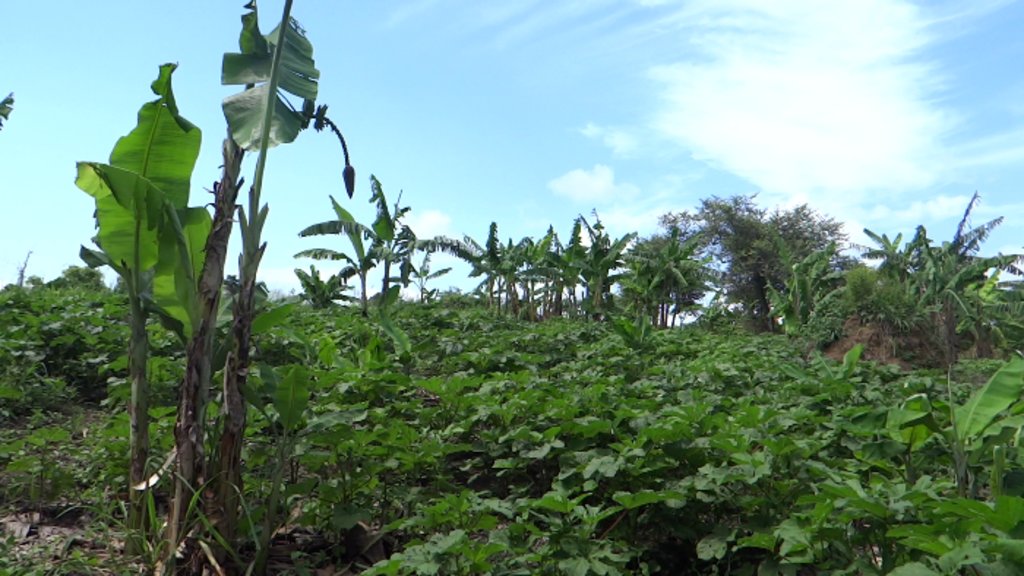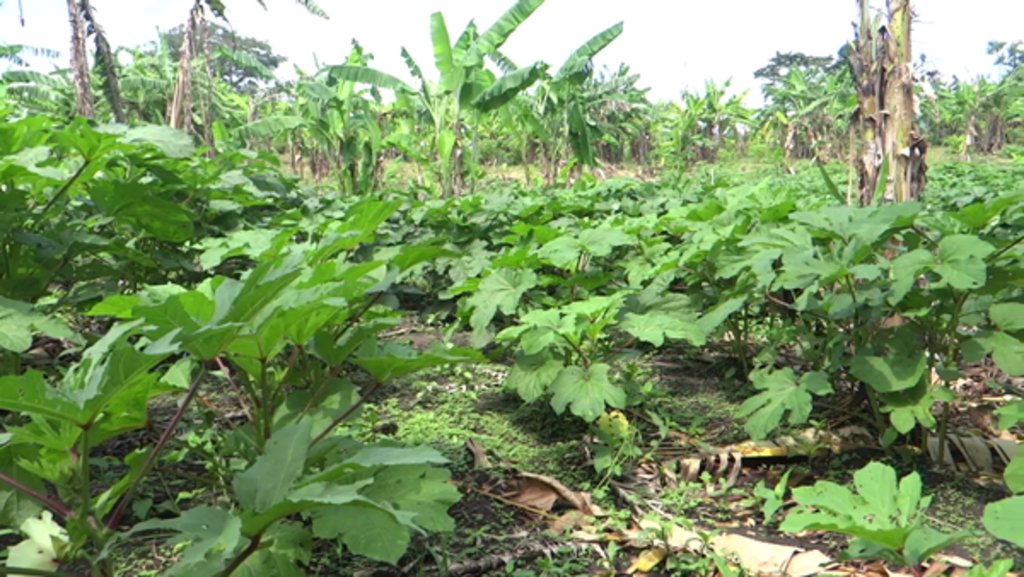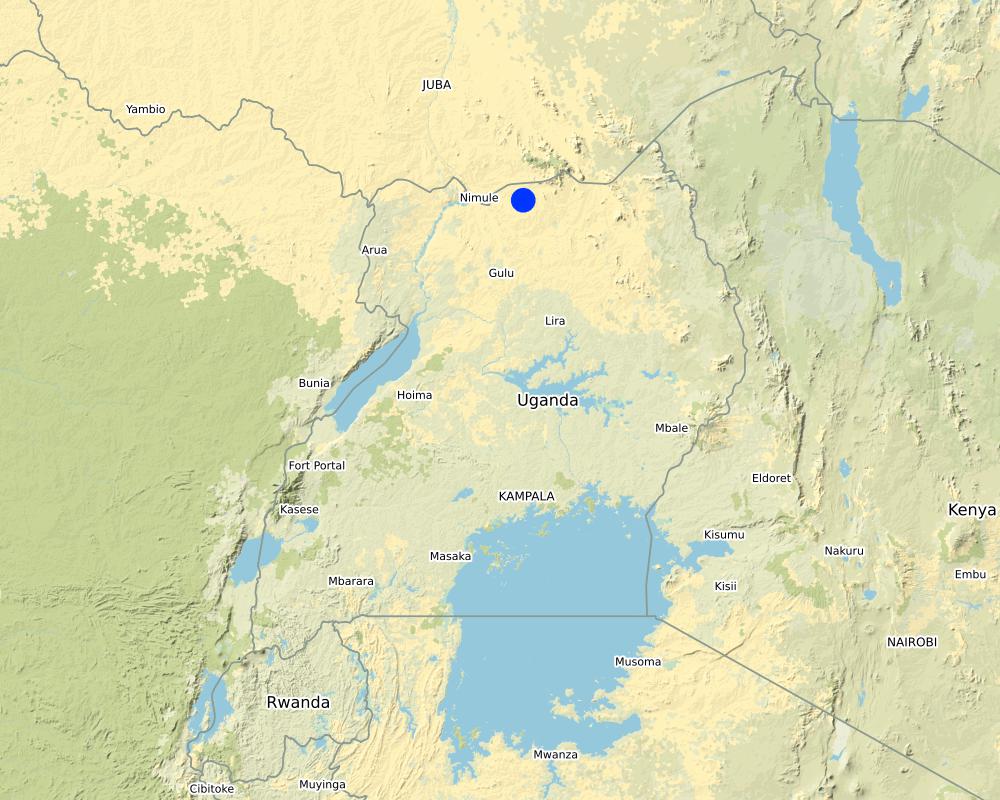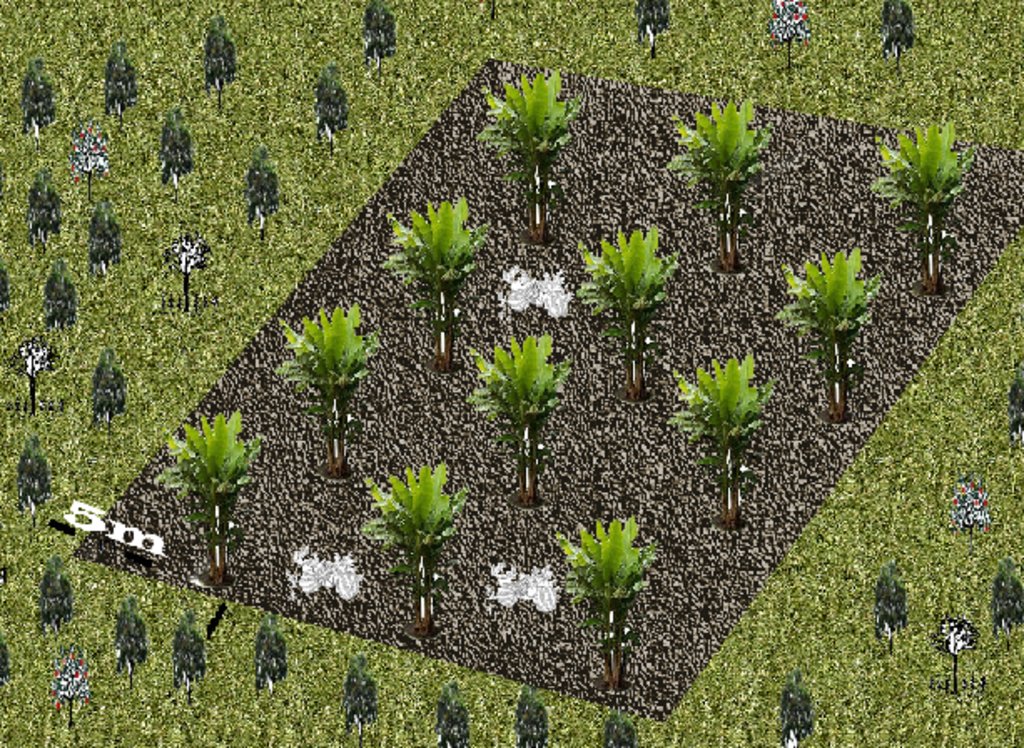Woodland-Protected Banana Cultivation for Increased Production and Household Income [Uganda]
- Creation:
- Update:
- Compiler: Bernard Fungo
- Editors: JOY TUKAHIRWA, Kamugisha Rick Nelson, betty adoch, Sunday Balla Amale
- Reviewers: John Stephen Tenywa, Udo Höggel
Pito Labolo ki pot dek
technologies_2839 - Uganda
View sections
Expand all Collapse all1. General information
1.2 Contact details of resource persons and institutions involved in the assessment and documentation of the Technology
Key resource person(s)
land user:
Pkechocon Alex
+256712262059 / +256788945199
Palwong Parish, Paboo sub county
Palwong Parish, Pabbo Sub county, Amuru District
Uganda
Name of project which facilitated the documentation/ evaluation of the Technology (if relevant)
Scaling-up SLM practices by smallholder farmers (IFAD)Name of the institution(s) which facilitated the documentation/ evaluation of the Technology (if relevant)
Uganda Landcare Network (ULN) - Uganda1.3 Conditions regarding the use of data documented through WOCAT
When were the data compiled (in the field)?
12/5/2017
The compiler and key resource person(s) accept the conditions regarding the use of data documented through WOCAT:
Ja
1.4 Declaration on sustainability of the described Technology
Is the Technology described here problematic with regard to land degradation, so that it cannot be declared a sustainable land management technology?
Nee
2. Description of the SLM Technology
2.1 Short description of the Technology
Definition of the Technology:
A banana plantation established in an area surrounded by natural woodland vegetation is protected from excessive drought and winds, ensuring continuous production and increased income throughout the year
2.2 Detailed description of the Technology
Description:
Strong dry winds in the plains of northern Uganda can be a serious challenge during dry periods, destroying perennial crops and farm structures. To overcome this challenge, farmers maintain blocks of natural vegetation around their plantations. In the case of this technology, the farmer has maintained natural vegetation around his banana plantation. Within the plantation there are other crops such as vegetables. The trees in the natural vegetation provide shade to the crops and act as wind breaks to the banana plantation.
The size of the plantation is approximately 2 acres. On either side of the plantation is a strip of natural vegetation with a variety of trees species but mainly drought-tolerant species such as Cobretum molle, Albizia coriaria and Accia seyal. Under these trees are grasses which are some times used for livestock. The distance between the banana plantation and the natural woodland is approximately 3 meters and the natural vegetation is approximately 5 meters wide. During the dry season the tall grass from the natural vegetation, if not used for livestock, is harvested and used as mulch in the banana plantation. This also serves to reduce the fire hazard that may spread from the natural vegetation into the plantations. It is also from the farmer's natural vegetation that sometimes poles are cut and used to support heavy bunches of growing bananas.
Generally, the technology does not require a lot of inputs, since bananas are a perennial crop requiring no regular purchase of seeds/seedlings. The major inputs that require regular supply are grass mulch and manure. The farmer usually gets the grass mulch from the natural woodland next to the bananas. He obtains the manure from either of his five cows in the Kraal or purchases additional animal manure from neighbors. On average the farmer adds three tons of manure each year and about a ton of mulch per year. The advantage is that mulch also decomposes easily and adds to the soil carbon and therefore the fertility of the soil. The labor for the work in the plantation is mainly household-based.
To be able to maintain his technology, the farmers need to have adequate labor to maintain a clear separation between the banana plantation and the natural woodland. The farmers also requires labor to manage the grass in the natural woodland so that it does not out grow to pose a fire risk and provide habitat for other dangerous animals like snakes and rodents.
This technology is suitable in areas where grazing is not a major farming activity because livestock can easily cross from the woodland into the banana plantation and destroy it in a very short time.
2.3 Photos of the Technology
2.4 Videos of the Technology
Comments, short description:
Video showing protected woodland under banana plantation in Lamwo District, Northern Uganda
Date:
12/5/2017
Location:
Pabbo Sub-county, Amuru District, Northern Uganda, Northern Uganda
Name of videographer:
Issa Aliga
2.5 Country/ region/ locations where the Technology has been applied and which are covered by this assessment
Country:
Uganda
Region/ State/ Province:
Northern Region,Uganda
Further specification of location:
Pabbo Sub-county, Amuru District, Northern Uganda
Map
×2.6 Date of implementation
Indicate year of implementation:
2009
2.7 Introduction of the Technology
Specify how the Technology was introduced:
- through land users' innovation
3. Classification of the SLM Technology
3.1 Main purpose(s) of the Technology
- reduce risk of disasters
- adapt to climate change/ extremes and its impacts
3.2 Current land use type(s) where the Technology is applied

Mixed (crops/ grazing/ trees), incl. agroforestry
- Agro-pastoralism
3.3 Further information about land use
Water supply for the land on which the Technology is applied:
- rainfed
Number of growing seasons per year:
- 2
Specify:
March to May and September to November
3.4 SLM group to which the Technology belongs
- agroforestry
- windbreak/ shelterbelt
- improved ground/ vegetation cover
3.5 Spread of the Technology
Specify the spread of the Technology:
- evenly spread over an area
If the Technology is evenly spread over an area, indicate approximate area covered:
- < 0.1 km2 (10 ha)
3.6 SLM measures comprising the Technology

agronomic measures
- A1: Vegetation/ soil cover

vegetative measures
- V1: Tree and shrub cover

structural measures
- S9: Shelters for plants and animals
Comments:
The area is fenced using local material such as poles from the woodland and sometimes live fences
3.7 Main types of land degradation addressed by the Technology

soil erosion by wind
- Et: loss of topsoil

physical soil deterioration
- Pc: compaction

biological degradation
- Bc: reduction of vegetation cover
3.8 Prevention, reduction, or restoration of land degradation
Specify the goal of the Technology with regard to land degradation:
- prevent land degradation
4. Technical specifications, implementation activities, inputs, and costs
4.1 Technical drawing of the Technology
4.2 Technical specifications/ explanations of technical drawing
Distance between banana plantation and woodland is approximately 5 meters with short grass (~ 3-5 cm height)
The width of the woodland is ~5 m
The banana plantation is ~ 2 acres
4.3 General information regarding the calculation of inputs and costs
Specify how costs and inputs were calculated:
- per Technology area
Indicate size and area unit:
2 acres
If using a local area unit, indicate conversion factor to one hectare:
2.5
other/ national currency (specify):
Uganda Shillings
Indicate exchange rate from USD to local currency (if relevant): 1 USD =:
3500.0
Indicate average wage cost of hired labour per day:
5000
4.4 Establishment activities
| Activity | Type of measure | Timing | |
|---|---|---|---|
| 1. | Slaching | Agronomic | Three times every season |
| 2. | Manure application | Agronomic | At start of theraininy eason |
| 3. | Mulching | Agronomic | At start of dry season |
4.5 Costs and inputs needed for establishment
| Specify input | Unit | Quantity | Costs per Unit | Total costs per input | % of costs borne by land users | |
|---|---|---|---|---|---|---|
| Labour | Slashing | Days | 60.0 | 5000.0 | 300000.0 | 100.0 |
| Labour | Manure application | Days | 20.0 | 5000.0 | 100000.0 | 100.0 |
| Labour | Mulching | Days | 20.0 | 5000.0 | 100000.0 | 100.0 |
| Plant material | Dry grass | Ton | 1.0 | 100000.0 | 100000.0 | 100.0 |
| Fertilizers and biocides | Animal manure | Ton | 2.0 | 150000.0 | 300000.0 | 100.0 |
| Total costs for establishment of the Technology | 900000.0 | |||||
4.6 Maintenance/ recurrent activities
| Activity | Type of measure | Timing/ frequency | |
|---|---|---|---|
| 1. | Slashing | Agronomic | Three times a season |
| 2. | Manure application | Agronomic | At start of rainy season |
| 3. | Mulching | Agronomic | At start of dry season |
4.7 Costs and inputs needed for maintenance/ recurrent activities (per year)
| Specify input | Unit | Quantity | Costs per Unit | Total costs per input | % of costs borne by land users | |
|---|---|---|---|---|---|---|
| Labour | Slashing | Days | 60.0 | 5000.0 | 300000.0 | 100.0 |
| Labour | Manure application | Days | 20.0 | 5000.0 | 100000.0 | 100.0 |
| Labour | Mulching | Days | 20.0 | 5000.0 | 100000.0 | 100.0 |
| Plant material | Dry grass | Ton | 1.0 | 100000.0 | 100000.0 | 100.0 |
| Fertilizers and biocides | Manure | Ton | 2.0 | 150000.0 | 300000.0 | 100.0 |
| Total costs for maintenance of the Technology | 900000.0 | |||||
4.8 Most important factors affecting the costs
Describe the most determinate factors affecting the costs:
Purchase and application of manure
5. Natural and human environment
5.1 Climate
Annual rainfall
- < 250 mm
- 251-500 mm
- 501-750 mm
- 751-1,000 mm
- 1,001-1,500 mm
- 1,501-2,000 mm
- 2,001-3,000 mm
- 3,001-4,000 mm
- > 4,000 mm
Agro-climatic zone
- sub-humid
5.2 Topography
Slopes on average:
- flat (0-2%)
- gentle (3-5%)
- moderate (6-10%)
- rolling (11-15%)
- hilly (16-30%)
- steep (31-60%)
- very steep (>60%)
Landforms:
- plateau/plains
- ridges
- mountain slopes
- hill slopes
- footslopes
- valley floors
Altitudinal zone:
- 0-100 m a.s.l.
- 101-500 m a.s.l.
- 501-1,000 m a.s.l.
- 1,001-1,500 m a.s.l.
- 1,501-2,000 m a.s.l.
- 2,001-2,500 m a.s.l.
- 2,501-3,000 m a.s.l.
- 3,001-4,000 m a.s.l.
- > 4,000 m a.s.l.
Indicate if the Technology is specifically applied in:
- not relevant
5.3 Soils
Soil depth on average:
- very shallow (0-20 cm)
- shallow (21-50 cm)
- moderately deep (51-80 cm)
- deep (81-120 cm)
- very deep (> 120 cm)
Soil texture (topsoil):
- medium (loamy, silty)
Soil texture (> 20 cm below surface):
- medium (loamy, silty)
Topsoil organic matter:
- medium (1-3%)
5.4 Water availability and quality
Ground water table:
< 5 m
Availability of surface water:
good
Water quality (untreated):
good drinking water
Is water salinity a problem?
Nee
Is flooding of the area occurring?
Nee
5.5 Biodiversity
Species diversity:
- medium
Habitat diversity:
- medium
5.6 Characteristics of land users applying the Technology
Sedentary or nomadic:
- Sedentary
Market orientation of production system:
- commercial/ market
Off-farm income:
- 10-50% of all income
Relative level of wealth:
- average
Individuals or groups:
- individual/ household
Level of mechanization:
- manual work
Gender:
- men
Age of land users:
- middle-aged
- elderly
5.7 Average area of land owned or leased by land users applying the Technology
- < 0.5 ha
- 0.5-1 ha
- 1-2 ha
- 2-5 ha
- 5-15 ha
- 15-50 ha
- 50-100 ha
- 100-500 ha
- 500-1,000 ha
- 1,000-10,000 ha
- > 10,000 ha
Is this considered small-, medium- or large-scale (referring to local context)?
- medium-scale
5.8 Land ownership, land use rights, and water use rights
Land ownership:
- individual, not titled
Land use rights:
- individual
Water use rights:
- individual
5.9 Access to services and infrastructure
health:
- poor
- moderate
- good
education:
- poor
- moderate
- good
technical assistance:
- poor
- moderate
- good
employment (e.g. off-farm):
- poor
- moderate
- good
markets:
- poor
- moderate
- good
energy:
- poor
- moderate
- good
roads and transport:
- poor
- moderate
- good
drinking water and sanitation:
- poor
- moderate
- good
financial services:
- poor
- moderate
- good
6. Impacts and concluding statements
6.1 On-site impacts the Technology has shown
Socio-economic impacts
Production
crop production
Comments/ specify:
Improved crop yields since effects of crops fall are reduced
land management
Comments/ specify:
Easy to manage field. Surrounding trees provide stakes for bananas
Income and costs
farm income
Comments/ specify:
More yield brings about more income the farmer
Ecological impacts
Soil
soil cover
Comments/ specify:
Grass provides additional mulch cover to the soil surface
nutrient cycling/ recharge
Comments/ specify:
Tree leaves and mulch decompose to replenish the nutrients lost
soil organic matter/ below ground C
Comments/ specify:
Tree leaves and mulch decompose to provide humus
Biodiversity: vegetation, animals
Vegetation cover
Comments/ specify:
More diverse vegetation types on the land
Climate and disaster risk reduction
fire risk
Comments/ specify:
Since grasses are cut and applied as mulch, fire does not easily spread in to the area
wind velocity
Comments/ specify:
Trees act as wind breaks to reduce wind speed
micro-climate
Comments/ specify:
The combination of trees, grass and bananas creates a conducive micro climate for biodiversity survival
6.2 Off-site impacts the Technology has shown
wind transported sediments
6.3 Exposure and sensitivity of the Technology to gradual climate change and climate-related extremes/ disasters (as perceived by land users)
Gradual climate change
Gradual climate change
| Season | Type of climatic change/ extreme | How does the Technology cope with it? | |
|---|---|---|---|
| annual temperature | decrease | moderately | |
| seasonal temperature | wet/ rainy season | decrease | moderately |
| annual rainfall | increase | well | |
| seasonal rainfall | wet/ rainy season | decrease | well |
Climate-related extremes (disasters)
Meteorological disasters
| How does the Technology cope with it? | |
|---|---|
| local windstorm | moderately |
Climatological disasters
| How does the Technology cope with it? | |
|---|---|
| drought | moderately |
| land fire | moderately |
6.4 Cost-benefit analysis
How do the benefits compare with the establishment costs (from land users’ perspective)?
Short-term returns:
positive
Long-term returns:
very positive
How do the benefits compare with the maintenance/ recurrent costs (from land users' perspective)?
Short-term returns:
positive
Long-term returns:
positive
Comments:
The farmer is able to realize some benefits within the first few years of establishment. However with time, benefits become more.
6.5 Adoption of the Technology
- single cases/ experimental
Of all those who have adopted the Technology, how many have did so spontaneously, i.e. without receiving any material incentives/ payments?
- 0-10%
6.6 Adaptation
Has the Technology been modified recently to adapt to changing conditions?
Nee
6.7 Strengths/ advantages/ opportunities of the Technology
| Strengths/ advantages/ opportunities in the land user’s view |
|---|
| The practices needed can be performed by the farmers without technical input |
| Multiple products from the gardens since bananas are continuous fruiters and the woodland provides continuous supply of fuel wood for domestic use |
| Strengths/ advantages/ opportunities in the compiler’s or other key resource person’s view |
|---|
| The woodland acts as a buffer against destruction by winds since bananas are very fragile crops under strong winds |
| The cost to maintaining the technology is generally, low, with no major external inputs |
6.8 Weaknesses/ disadvantages/ risks of the Technology and ways of overcoming them
| Weaknesses/ disadvantages/ risks in the land user’s view | How can they be overcome? |
|---|---|
| The woodland adjacent to the banana plantation can acts as hiding place for wild animals as well as pests and diseases | Ensure that the woodland is properly cleared, maintaining low grass and not allowing the branches to overlap between trees |
| Land shortage cannot allow the expansion of the woodland buffer, thereby limiting effectiveness of the buffer | Alter the species composition of the woodland to include tall trees among the shorter ones |
| Weaknesses/ disadvantages/ risks in the compiler’s or other key resource person’s view | How can they be overcome? |
|---|---|
| Bananas are susceptible to pests and diseases that may come from the woodland | Maintain proper plant hygiene in the banana plantation and use pesticides where necessary |
| Maintaining a banana plantation requires a lot of labor to apply manure and mulch | Apply mulch only when necessary |
| Bananas are easily damaged by drought, which is a common occurrence in northern Uganda | Maintain heavy mulch during the dry season to conserve soil moisture and ensure crop survival |
7. References and links
7.1 Methods/ sources of information
- field visits, field surveys
1
- interviews with land users
1
Links and modules
Expand all Collapse allLinks
No links
Modules
No modules






